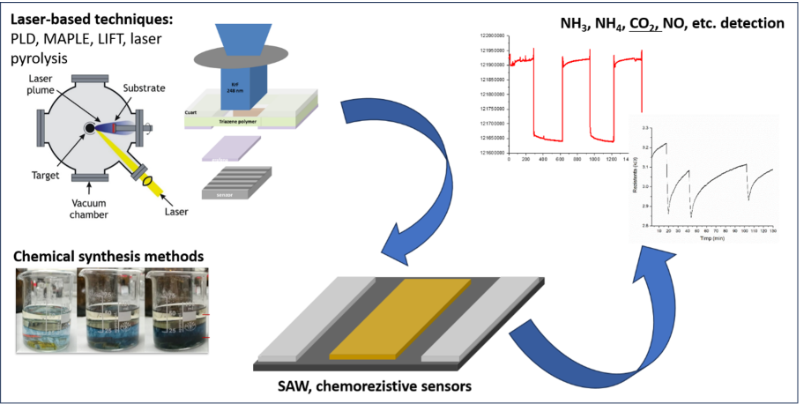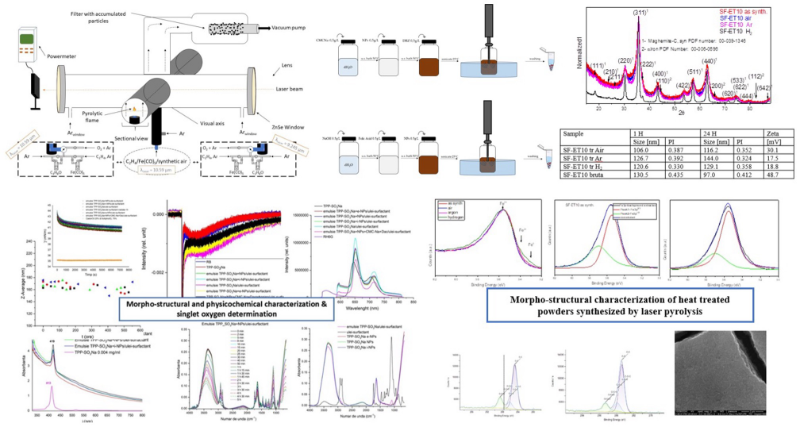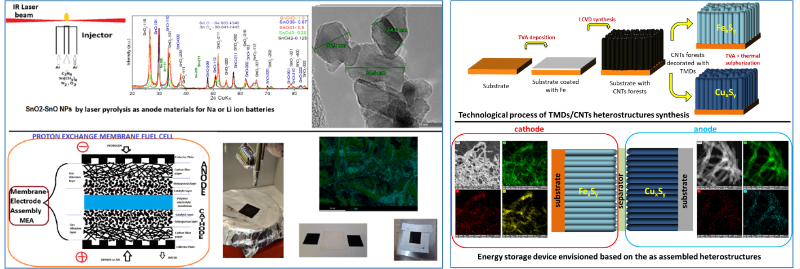
Schema de realizare a proiectului 23 03 01 - Anul 2024 - Etapa I
Contractul nr.: 30N/12.01.2023
Proiectul: "Dezvoltarea de solutii inovatoare si tehnologii de fabricație avansată cu laseri, plasmă și radiații pentru rezolvarea problemelor societale"
Faza 1/2024: "Tehnici și dispozitive avansate de analiză pentru medicina personalizată"
Responsabil fază: Dr. Felix SIMA
Termen de încheiere a fazei: 09.05.2024
Abstract:
In this project we have developed techniques and advanced analytical methods for personalized medicine. Three studies have been carried out to this purpose.
In a first study, we have demonstrated that material processing techniques with ultra-short laser pulses allow improving the micro- and nano-fabrication resolution with the advantage of building hierachical geometries as compared with lithography techniques. In addition, we have succeded the integration of micropumping systems inside microfluidic devices by fabricating ITO electrodes with controlled dimensions. Microfluidic and nanofluidic devices offer ideal solutions for observing cancer cells ability to migrate in cnarrow spaces that mimic intravasion-extravasion processes similar with in vivo micro-environment.
In the second study, have analysed the distinct characteristics of a digital fingerprint, using Er(x%):BGZO powders. The goal of this study was to develop a chemicaly and thermaly stable material, with special luminescence properties, for superior conversion at low pumping powers at near infrared. To this purpose, we investigated the emission properties by superior conversion in green of BGZO material dopped with Er3+ ions. The most promising results were obtained for BGZO sample dopped with 4 at% Er3+. The study on residues of finger surface may give the possibility to use digital fingerprint for personalized medicine, reflecting the transition from the model "one-size-fits-all" to another personalized and dynamic model.
The research in the third study focused on three different types of cancer in the ORL sphere: microinvasive squamous cell carcinoma at the base of the tongue, epithelial-myoepithelial carcinoma with increased focal mitotic activity in the maxillary sinus, and poorly keratinized squamous cell carcinoma G3. The obtained data contribute to identifying significant parameters, such as the maximum fluorescence intensity and autofluorescence lifetime, which can be used in discriminating between healthy and malignant tissues in the ORL sphere. Thus, integrating autofluorescence analysis and FTIR spectroscopy could improve the diagnostic and characterization capacity of ORL conditions, holding significant potential in the medical field.
Abstract grafic:
Contractul nr.: 30N/12.01.2023
Proiectul: "Dezvoltarea de solutii inovatoare si tehnologii de fabricație avansată cu laseri, plasmă și radiații pentru rezolvarea problemelor societale"
Faza 7/2024: "Realizarea și testarea componentelor fotonice și electronice de comandă pentru sistemul laser cu pulsuri sub-picosecunde"
Responsabil fază: Dr. Nicolaie PAVEL
Termen de încheiere a fazei: 06.06.2024
Abstract:
During this stage of the contract, efficient laser emission (at 1062 nm) was obtained from a Nd:LaxGdyYzSc4-x-y-z(BO3)4 (Nd:LGYSB) crystal, using optical pumping with a laser diode. The free-running operation regime, under quasi-continuous and continuous pumping, was investigated.
Ca3(Li,Ta,Ga)5O12 - (CLTGG) type ceramic samples doped with variable concentration of Tb3+ were obtained and investigated. The effective emission cross section was estimated at 542 nm; the obtained value (2.54×10-21 cm2) indicates that a CLTGG:Tb type crystal (15 at.%) can be a potential active medium for laser emission at 542 nm. CLTGG:Tb (15 at.%), Yb (y at.%) type co-doped ceramic samples were obtained and investigated. Emission spectra of the Tb3+ ion were performed in the visible range with infrared excitation (at 973 nm). The ceramic medium doped with Tb (15 at.%), Yb (5 at.%) presented the highest intensity for the emission line at 542 nm.
Transparent Y2O3/x-at.% Nd:Y2O3 (x= 0.5, 1.0, 1.5) and Y2O3/y-at.% Yb:Y2O3 (y= 3.0, 5.0, 8.0) composite ceramics were obtained by solid-state reaction and multi-step sintering method. The ceramic media presents a good quality, confirmed by the results obtained from the structural, morphological, and optical investigations.
Laser mirrors at 532 nm were made by depositing thin films of TiO2 and SiO2 on quartz substrates by the RF-magnetron sputtering method. Laser mirrors with 7, 11 and 17 layers were obtained using industrial quartz substrates. All the deposited films showed very good quality in terms of roughness, the roughnesses measured by AFM, profilometry and ellipsometry being of subnanometric order up to a few nm. A parametric study was carried out to optimize the reproducible obtaining of Bragg mirrors (heterostructures TiO2/SiO2/TiO2/SiO2/TiO2/SiO2/TiO2 on quartz substrate) on a large area by the pulsed laser deposition technique (PLD and RF-PLD), targeting the reflectance at the wavelength of 532 nm. By PLD and RF-PLD heterostructures containing 7 alternate layers of SiO2/TiO2 on silicon substrate, dense and compact, with a very low roughness [~3 nm (SE) and ~9 nm (AFM)] were obtained. Multilayer structures (TiO2/SiO2)×3 and (TiO2/SiO2)×7 were made using the TVA method in an oxygen-controlled atmosphere.
The design of the sub-picosecond pulsed laser system and the related command and control system (global control block diagram including synchronization, selection and execution elements; structure of the command and control system; input and output interfaces) was carried out.
Abstract grafic:
Contractul nr.: 30N/12.01.2023
Proiectul: "Dezvoltarea de solutii inovatoare si tehnologii de fabricație avansată cu laseri, plasmă și radiații pentru rezolvarea problemelor societale"
Faza 8/2024: "Integrarea și caracterizarea structurilor de senzori"
Responsabil fază: Dr. Alexandra Palla-Papavlu
Termen de încheiere a fazei: 26.07.2024
Abstract:
Contemporary agriculture faces numerous challenges, including labor shortages, climate unpredictability, and poor soil due to insufficient land management. To address these issues, technology offers advanced solutions through the development of sensors and detection platforms for smart agriculture. This project focuses on developing manufacturing technologies for sensors and detection platforms aimed at both smart agriculture and public safety, along with monitoring and controlling the quality of advanced manufacturing processes.
Within the project, experimental models of sensors with thin layers of piezoelectric solid solutions for detecting gases such as CO2 and NH4 were developed. Thin layers of barium titanate (BaTiO3) were deposited on ceramic alumina (Al2O3) substrates through pulsed laser deposition (PLD) and characterized morphologically, chemically, and electrically. Tests showed significant frequency shifts in the presence of gases, demonstrating the importance of deposition parameters.
Additionally, conductometric sensors based on metal oxides (SnO2-ZnO) and polyaniline (PANI) for methane (CH4) detection at room temperature were fabricated. Platinum metal electrodes were deposited through sputtering, and the sensitive material was added via PLD and chemical oxidative polymerization.
The LIFT technique (Laser-Induced Forward Transfer) was used to fabricate chemorezistive sensors based on hybrid organic-inorganic materials (PEDOT:PSS-graphene oxide). This technique allowed for the precise transfer of materials onto receiver substrates, resulting in sensors capable of detecting NO at room temperature.
To improve the physical and chemical properties of the sensors, electron beam irradiation was utilized. This process was carried out using a linear electron accelerator, and dosimetry was precisely monitored using graphite calorimeters and B3 radiochromic films, calibrated according to international standards.
In conclusion, the project demonstrated success in developing and characterizing advanced sensors for smart agriculture. The use of technologies such as PLD, LIFT, and electron beam irradiation led to the creation of high-performance sensors capable of rapid and efficient responses to the presence of target gases. These achievements significantly contribute to the improvement of agricultural process monitoring and control, promoting more efficient and sustainable agriculture.
Abstract grafic:
Contractul nr.: 30N/12.01.2023
Proiectul: "Dezvoltarea de solutii inovatoare si tehnologii de fabricație avansată cu laseri, plasmă și radiații pentru rezolvarea problemelor societale"
Faza 9/2024: "Studii analitice și experimentale pentru optimizarea proprietăților nanofluidelor magnetice funcționalizate cu compuși antitumorali"
Responsabil fază: Dr. Florian DUMITRACHE, Dr. Angela STAICU
Termen de încheiere a fazei: 07.11.2024
Abstract:
Iron oxide nanoparticles synthesized by laser pyrolysis using different sensitizers: ethylene, isopropanol, and ethanol were investigated. Morpho-structural analysis confirmed the presence of a nanometric materials with reduced dimensions, a cvasi-spherical shale and a tendency to agglomerate in chain-like structures. All powders presented a high stability in water and a reduced hydrodynamic diameter. Stabilisation/functionalization with dextran, CMCNa, dacarbazine and folic acid, as well as optimisation of these protocols were achieved. Thermal treatment of the nanoparticles was attained in order to generate higher magnetic properties, over the specific value of freshly nucleated NPs, without compromising the suspension capacity. The γ-Fe2O3 NPs were synthesized by laser pyrolysis using ethanol, and then thermally treated at 250oC for 3h in continous flux of gas: air, argon, hydrogen. The structural alterations were minimal if the treatements were done in Ar or air, however the crystal dimension grows significantly, from 5.2 nm for the untreated NPs to 13 nm for the hydrogen treated NPs. Nanofluids prepared in water using these NPs exhibited excellent stability in time (1 and 24h), with a agglomerate dimension of around 100 nm and a zeta potential over 45 mV. The thermal treatments affect the stability in timp resonably low, however they do diminish the zeta potential.
Photosensitizer TPP-SO3Na emulsions that include nanoparticles such as e-NPs, NPs, i-NPs, and Dacarbazine-loaded NPs were studied. They were analyzed from a morpho-structural and physicochemical perspective using various techniques, including DLS, UV-Vis absorption, FTIR, LIF spectroscopy, and dynamic surface tension analysis.
The results showed that the emulsions have a stable droplet size between 150-170 nm, which remains consistent throughout the experiments, indicating excellent stability.
The stability of the emulsions was also confirmed by FTIR-ATR analysis, the sample with the highest stability was the TPP-SO3Na+i-NPs/oil-surfactant emulsion. Singlet oxygen generation tests revealed a significant increase in lifetime and signal intensity for emulsions compared to the simple TPP-SO3Na solution.
The analysis of surface tension dynamics indicates that no significant migration of dispersed phase particles to the surface by coalescence of oil droplets occurs, and the emulsions remain uniform and stable.
In conclusion, these TPP-SO3Na emulsions incorporating nanoparticles exhibit remarkable stability and can extend the lifetime of singlet oxygen, making them promising for potential applications in photodynamic therapies and efficient drug delivery.
Abstract grafic:
Contractul nr.: 30N/12.01.2023
Proiectul: "Dezvoltarea de solutii inovatoare si tehnologii de fabricație avansată cu laseri, plasmă și radiații pentru rezolvarea problemelor societale"
Faza 9/2024: "Optimizarea proceselor tehnologice de sinteză și fabricare a elementelor componente pentru stocare de energie - partial etapa I"
Responsabil fază: Dr. Mihai ZAMFIR, Dr. Nicu SCĂRIȘOREANU
Termen de încheiere a fazei: 22.11.2024
Abstract:
Laser pyrolysis method was employed for the synthesis of Co-free anode materials for Li or Na ion batteries based on controlled mixtures of nano tin oxides (SnO2 and SnO) starting from Sn(CH3)4 and using C2H4 senzitizer/carrier in presence of various flows of O2 (+N2). Morphostructural, compositional and liquid-dispersive properties were reported using XRD, EDS, XPS, TEM, DLS - Zeta Potential techniques.
Catalyst Coated Substrate (CCS) method was employed for the fabrication of MEA for PEMFC. First the Gas Diffusion Layers (GDLs) are constructed by coating of dimensionally tailored carbon fiber papers with Mesoporous Layers (MPLs) form carbon nanoparticles suspensions in isopropanol with small amount of hydrophobic perfluoroethylene by aerograph spraying. Then the catalytic layers (CLs) made from commercial or laser pyrolysis made carbon-based nanoparticles decorated with different amount of ultrafine Pt particles for cathode and anode and additivated with sulfonated fluoropolymer is sprayed over the MPLs from dispersions. Finally, the commercial polymer electrolyte membrane is hot-pressed between the two CLs supported on GDLs to obtain a functional MEA.
Transition metal chalcogenides (TMCs) stand out as some of the most intriguing candidates for both fundamental research and potential applications in the energy field. Their synthesis in nanostructured form and in heteroarchitectures combined with carbon-based materials holds enormous potential, primarily due to the high surface-to-volume ratio, which provides space to accommodate volume changes during charge/discharge cycles, while also promoting rapid ionic transport and short-range interactions between charge carriers, enabling high charge/discharge rates. To achieve these nanostructured architectures, methods and techniques with a high degree of scalability and technological transfer potential to industry partners have been employed: Thermionic Vacuum Arc (TVA) plasma technique, Laser-Assisted Chemical Vapor Deposition (LCVD), and thermal sulfurization.
Abstract grafic:





